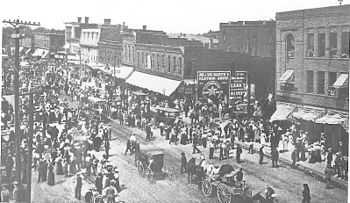History of Columbia, Missouri
This article is about the History of the City of Columbia, Missouri.
City founding and early history

The Columbia area was once part of the Mississippian culture and home to the Mound Builders. When European explorers arrived the area was populated by the Osage and Missouri Indians. In 1678 La Salle claimed all of Missouri for France. The Lewis and Clark Expedition passed by the area on the Missouri River in 1803. In 1806, Daniel Boone and his sons established a salt lick 40 miles (64 km) northwest of Columbia. The Booneslick Trail wound from Kentucky through St. Charles, Missouri to the salt lick. In 1818 a group of settlers, incorporated under the Smithton Land Company, purchased over 2,000 acres (8.1 km2) and established the village of Smithton less than a mile from current day downtown Columbia. In 1821 the settlers moved, because of lack of water, across the Flat Branch to the plateau between the Flat Branch and Hinkson creeks in what is now the downtown district. They renamed the settlement Columbia—a historical name for the United States.
19th century expansion and growth
The roots of Columbia's three economic foundations—education, medicine, and insurance—can be traced back almost to incorporation in 1821. Original plans for the town set aside land for a state university. Columbia College (distinct from today's), later to become the University of Missouri, was founded in 1839. When the state legislature decided to establish a state university, Columbia raised three times as much money as any other competing city and donated the land that is today the Francis Quadrangle. Stephens College had opened six years earlier in 1833 as the Columbia Female Academy. Soon other educational institutions were founded in Columbia such as Christian Female College, which later became the current Columbia College. The city benefited from being a stagecoach stop of the Santa Fe and Oregon trails, and later from the Missouri-Kansas-Texas Railroad. In 1822 the first hospital was set up by William Jewell. In 1830 the first newspaper was begun; in 1832 the first theater in the state was opened; and in 1835 the states first agricultural fair was held. By 1839 the population (13,000) and wealth of Boone County was exceeded in Missouri only by that of St. Louis County.
Columbia during the Civil War and Reconstruction

Columbia's infrastructure was largely untouched by the Civil War, although several major battles occurred nearby at Boonville and Centralia. The town was heavily garrisoned by Union troops, and though the city was pro-union the surrounding areas of Boone County and the rest of central Missouri was decidedly pro-south. During reconstruction the town saw steady growth in size, and continued to expand in all directions.
20th century
The 20th century saw Columbia's prominence as an educational center rise even further. It became home to the headquarters of the University of Missouri System, Stephens College and Columbia College. It became a transportation crossroads when U.S. Route 63 and U.S. Route 40, the latter now present-day Interstate 70, were routed through the city. Soon after the city opened the Columbia Regional Airport. During this time two insurance companies established headquarters in Columbia, Shelter Insurance and State Farm Insurance. The latter 20th century saw tremendous growth, and by the end of the century the population was over 80,000 in the city proper.
Recent developments
In the early 2000s Columbia embarked on a plan[1] to manage the continued growth. The city is today growing especially towards the Missouri River in southwest Boone County. The downtown district has maintained its status as a cultural center and is undergoing significant development in both residential and commercial sectors. The University of Missouri, which experienced record enrollment in 2006, is undertaking significant construction.
See also
History of the University of Missouri
References
- Switzler, Wm. F. (1882) History of Boone County. St. Louis: Western Historical Company.
- Ohman, Marian M. (1979) "Oh! Justice — .": The History of Boone County Courthouses. Columbia: University of Missouri: Extension Division
- Stephens, E. W. (1875) "History of Boone County." An Illustrated Historical Atlas of Boone County, Missouri. Philadelphia: Edwards Brothers
References
| ||||||||||||||||
